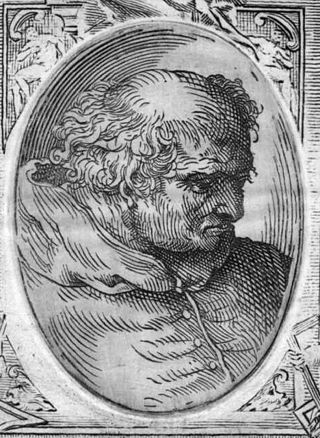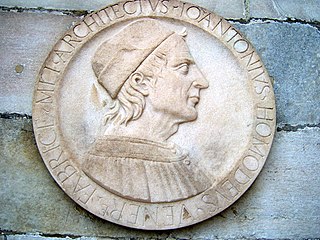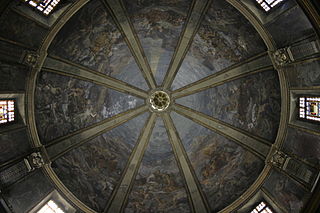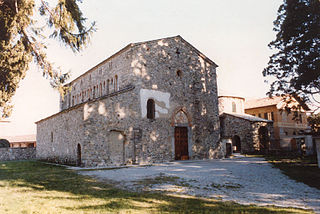
Galeazzo Alessi was an Italian architect from Perugia, known throughout Europe for his distinctive style based on his enthusiasm for ancient architecture. He studied drawing for civil and military architecture under the direction of Giovanni Battista Caporali.

Donato Bramante, born as Donato di Pascuccio d'Antonio and also known as Bramante Lazzari, was an Italian architect and painter. He introduced Renaissance architecture to Milan and the High Renaissance style to Rome, where his plan for St. Peter's Basilica formed the basis of the design executed by Michelangelo. His Tempietto marked the beginning of the High Renaissance in Rome (1502) when Pope Julius II appointed him to build a sanctuary over the spot where Peter was martyred.

Ambrogio Borgognone was an Italian painter of the Renaissance period active in and near Milan.

Bartolomeo Suardi, best known as Bramantino, was an Italian painter and architect, mainly active in his native Milan.

Giovanni Antonio Amadeo was an Italian Renaissance sculptor of the Early Renaissance, architect, and engineer. He dominated late fifteenth-century Lombard architecture and sculpture.

Andrea Appiani was an Italian neoclassical painter.

Marcellina was born in Trier, Gaul the daughter of the Praetorian prefect of Gaul, and was the elder sister of Ambrose of Milan and Satyrus of Milan. Marcellina devoted her life as a consecrated virgin to the practice of prayer and asceticism. Her feast is on 17 July.

Giulio Cesare Procaccini (1574–1625) was an Italian painter and sculptor of the early Baroque era in Milan.

Santa Maria presso San Satiro is a church in Milan. The Italian Renaissance structure (1476–1482) houses the early medieval shrine to Satyrus, brother of Saint Ambrose. The church is known for its false apse, an early example of trompe-l'œil, attributed to Donato Bramante.
Ambrogio Besozzi or Giovanni Ambrogio Besozzi (1648–1706) was an Italian painter of the Baroque period.

Giovanni Battagio was an Italian Renaissance sculptor and architect.

Agostino de Fondulis was an Italian sculptor and architect active in Lombardy.

Vigilius of Trent is venerated as the patron saint and bishop of Trent. He should not be confused with the pope of the same name.

Carlo Urbino (1525/30–1585) was an Italian painter of the Renaissance.

Agostino Comerio was an Italian painter, active mainly in Northern Italy.
Silvio Cosini was an Italian sculptor and stuccoist, mainly active in Florence. His works were in the style of Michelangelo, though he was trained by Andrea Ferrucci in Florence. Ferrucci obtained for him his first independent commission was in 1522, and included the decoration of the tomb of Raffaello Maffei in San Lino at Volterra. He usually worked in collaboration with other artists, including his brother Cosini.

The Basilica di San Vincenzo is a church in Galliano, a frazione of Cantù, in Lombardy, northern Italy. An example of local Romanesque architecture, it was founded in 1007. The complex includes also a baptistry, dedicated to St. John the Baptist.

Cesare Magni or Magno (c.1495–1534) was an Italian painter of the Leonardeschi school. He was born and died in Milan, and was an illegitimate son of Francesco Magni, a member of a well-known family of that city.

The following outline is provided as an overview of and topical guide to Milan:

















